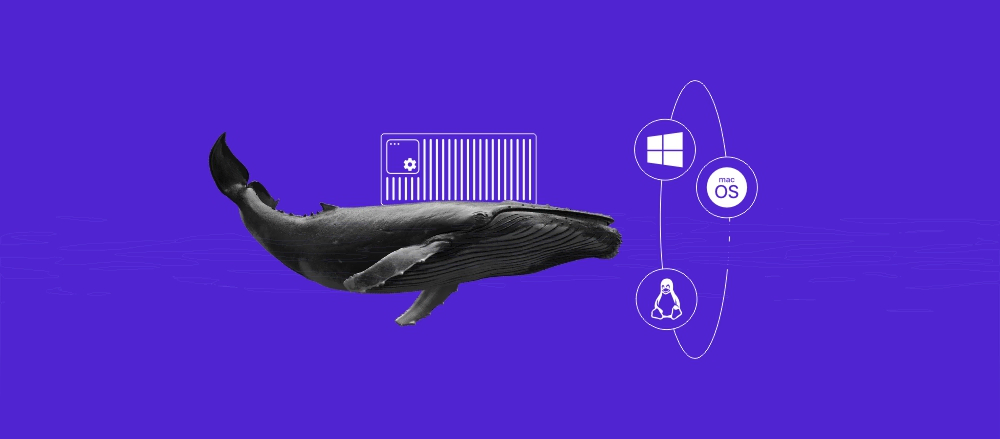How to optimize a dedicated game server for maximum performance
A responsive server is crucial for an optimal multiplayer gaming experience. A poorly performing host can cause a significant lag or even disconnection, especially when many players access the system at the same time.
Applying proper optimization strategies can maximize your server’s performance. For example, efficiently allocating the host’s hardware usage ensures you don’t waste resources on unnecessary processes.
This article will explain how to optimize a dedicated server to achieve maximum performance. We will explore methods for both software and hardware management to help you find exactly what you need.
Dedicated game server optimization strategies
To optimize your game server effectively, you can perform software optimization and network configuration, manage your server resources, tweak game settings, monitor server performance, and balance the load.
In this section, we’ll examine six effective optimization strategies for improving the performance of your gaming virtual private server (VPS) and providing an optimal gameplay experience.
Software optimization
On the software level, optimizing your game server involves minimizing unnecessary packages that can waste resources. Here are several practices to consider.
Choose lightweight software
Installing lightweight software helps free up your server hardware resources, which you can reallocate for other components. For example, we recommend using the Linux operating system instead of Windows since it runs more efficiently.
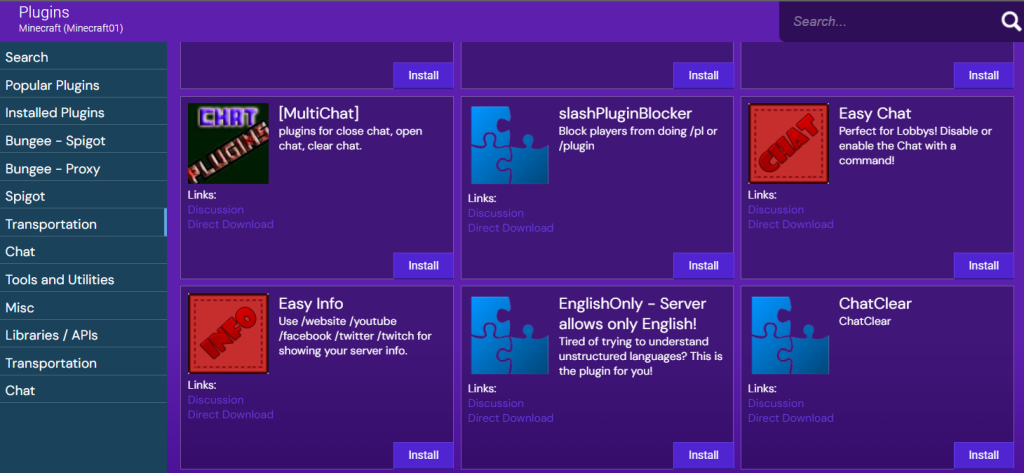
Also, choose lighter extensions for your game based on user reviews or developer recommendations. To simplify the task, manage the mods and plugins on your server using Hostinger’s Game Panel.
Minimize installed add-ons
Installing too many mods or extensions in your game server can significantly reduce performance. In addition to consuming storage space, loading them also requires more RAM and CPU power.
To optimize your server performance, regularly check and remove unused add-ons. While this process is relatively safe, we recommend backing up your VPS files and checking with users to avoid removing a wrong mod.
Update packages regularly
Regular software updates ensure the newest security patches, bug fixes, and performance improvements. In addition to the game server components, regularly update your system packages too.
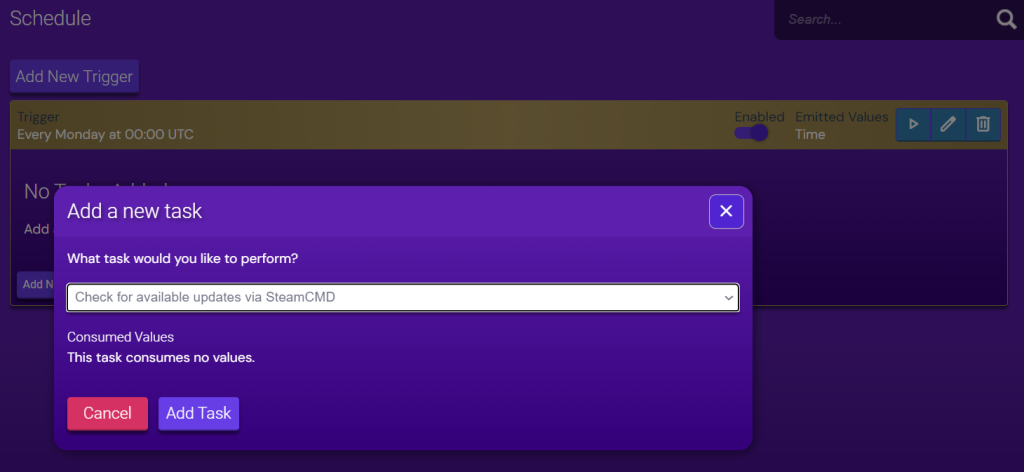
To simplify the process, schedule automatic server software updates using a cron job. Alternatively, Hostinger game server hosting users can do so without any command by configuring a new task in the Game Panel.
Network configuration
To enable multiplayer gameplay, your server connects and exchanges data with players’ computers over a network. Optimizing this transfer process is crucial to avoid performance issues and ensure responsiveness.
An important measure is choosing a server location closest to your audience base. This reduces the travel distance between the host and the clients to minimize latency, resulting in a lag-free gaming experience.
Hostinger’s game server hosting offers multiple data centers across different continents, including North America, Asia, and Europe. Users can freely choose one that suits them and switch to a different location anytime.
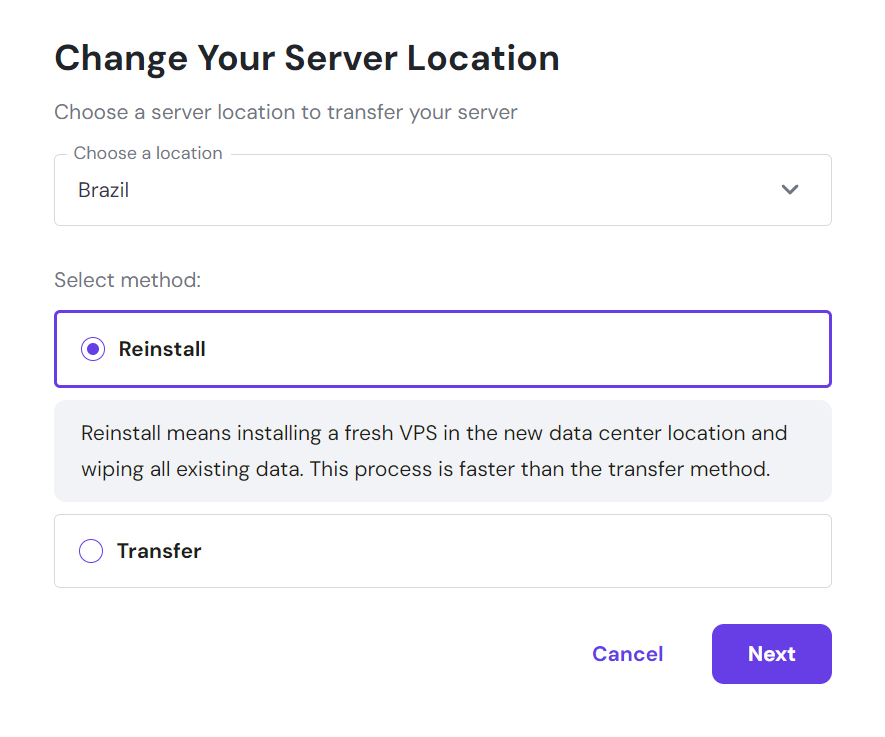
You can also set up a reverse proxy using a solution like Cloudflare Spectrum. It routes traffic to a data center closest to players’ location to reduce latency and maintain responsiveness.
Resource management
Managing your server’s resources ensures you don’t misallocate computing power for unnecessary tasks. Instead, you can repurpose it to other essential components to maintain stability.
On the VPS side, you can manage your game server resource usage using virtualization tools like Docker. It lets you package services in separate isolated containers, each with a custom hardware usage limit.
For example, you can put the game server instance on a container with a high resource allocation. Meanwhile, reserve the one with a lower usage limit for external services like APIs or plugins.
You can also apply a soft limit to dynamically reallocate resources according to a specific rule. Doing so enables flexible hardware management to ensure each service receives enough computing power.
Game server settings optimization
Games with dedicated servers typically provide a configuration file with various parameters that affect performance. You can change it using a text editor like nano or Hostinger Game Panel’s intuitive setting menu.

Here are several common server settings and their suggested values. After changing the configuration, remember to run tests and monitor the host’s performance to ensure stability.
Memory limit
Memory limit sets the maximum RAM size your gaming server can use. To maintain optimal performance, you should ideally set it as high as possible but below your system’s total memory capacity.
Allocating all your VPS RAM can cause instability because other services, like the database and operating system, won’t get enough resources.
Since the ideal value also differs across games, check the documentation before increasing the limit. Also, consider factors like plugins, mods, and player slots since they require more RAM.
Maximum ping
Several games let you automatically kick or reject a player if their ping exceeds a threshold. A ping measures the time a packet needs to travel between the client and the server. The higher the value, the higher the latency and input lag.
Setting a ping limit ensures players who can connect to the server have optimal gameplay experience. For those with a high network latency, you can set up a host closer to their geographical location to minimize lag.
For casual games like Stardewvalley, 100 ms ping is acceptable. However, competitive eSport titles like Counter-Strike and DoTA 2 require lower latency, preferably under 80 ms.
Map size
A big map requires higher computing power since your VPS must load more assets and scripts. To maintain an optimal gaming experience, we recommend setting it based on the number of players on your server.
If you have a small player base, setting the map too large can waste resources since some of the areas might be vacant.
For games with a fixed map size, like Minecraft and Unturned, you can improve server performance by reducing the draw distance. It enables your system to load assets near the players only.
Player slot
The number of players significantly affects your game server RAM consumption. The requirements also differ depending on the title. For example, a player slot in Project Zomboid requires an additional 500 MB of memory on top of 2 GB for the system.
Optimizing player slots is especially important for public servers that allow everyone to join. We recommend starting with a low limit, like 8 or 10, and gradually increasing it if you still have the resources.
Auto save
Game servers save the current gameplay state at a specific interval to ensure players don’t lose progress. During the process, your system might experience a performance hiccup since this task requires writing data on the storage.
It is especially noticeable for hosting with a slower, disk-based storage type. If you use a VPS with high-performance solid-state drives like Hostinger’s, the writing process is significantly quicker, resulting in less lag.
Prolonging the interval can help reduce the occasional lag for less powerful VPSs. We recommend setting it to 30 minutes at the maximum since a higher value might be prone to accidental data loss.
Server monitoring and performance tuning
Monitoring your game server gives you accurate insights into resource usage, which can help you identify areas for improvement.
Popular server monitoring tools include Grafana, New Relic, and Prometheus. If you don’t have the time to set them up, use Hostinger’s built-in monitoring tool in hPanel and Game Panel.
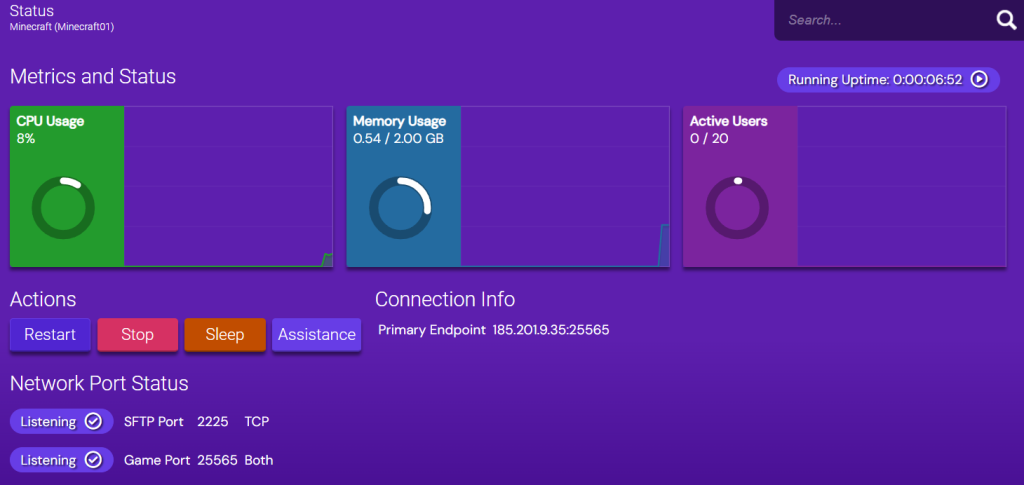
Once you configure the monitoring tools, identify your server performance metrics. These may include system uptime, player ping, CPU utilization, memory usage, and storage consumption.
Now that your server is online and players have started joining the game check the performance metrics. Use the numbers as the baseline reference – the ideal operating conditions for your VPS.
When you track the server performance, compare the stats with the baseline performance. This enables you to identify deviations that might indicate potential issues.
Using Hostinger's Kodee to manage your game server
If you use Hostinger’s game hosting plan, ask the Kodee AI assistant to manage you game server. Simply enter the prompts and Kodee will handle the rest.
For example, you can ask it “Check the resource usage of my game server,” “Reboot my Minecraft server instance,” and “Upgrade my Minecraft server instance and restart it afterward.”
Load balancing and scalability techniques
As the number of players and mods in your server increases, you must scale the hosting environment to accommodate their needs. Otherwise, your system will run out of resources and perform poorly.
There are two ways to scale a game server – vertically by upgrading the current system or horizontally by adding new instances. While both are viable strategies, each has its own pros and cons.
Vertical scaling
Vertical scaling is simpler since you don’t have to duplicate your files or set up a new system. Moreover, Hostinger’s VPS plans let you upgrade your resources seamlessly without downtime.
This method also provides a single point of management for a more efficient workflow and lower network overhead. Some applications might work more stably in a centralized environment.
However, vertical scaling can be limited if your hosting provider doesn’t offer a more powerful plan. It also creates a single point of failure, meaning you don’t have a backup system to take over during downtime.
If you plan to scale your server vertically, we recommend a host with a powerful higher-tier plan, like Hostinger’s Game Panel 8. To help you make an informed decision, read our best game server hosting providers tutorial.
Horizontal scaling
Horizontal scaling is more flexible since you can set up multiple systems to offload the traffic from the main game server. If you already use the most powerful plan from your hosting provider, you can simply configure a new instance.
In addition, if a game server fails, others can take over to maintain service uptime. However, horizontal scaling is more difficult and time-consuming. It is also expensive and might cause incompatibility issues for some applications.
A popular technique for horizontal scaling is setting up a load balancer. This system acts as an intermediary that distributes traffic evenly across multiple application servers to optimize stability.
You can also implement microservices architecture, breaking down your game server components into multiple services and hosting them separately. For instance, you can divide Minecraft plugins into different applications and connect them using the Microservice API.
Important! For most users, vertical scaling is enough to accommodate multiplayer gaming. Horizontal scaling is typically useful for game developers or large eSport platforms like FACEIT.
Security measures for game servers
In addition to responsiveness, game server safety is important to maintain uptime and data integrity. Here are several VPS security measures to consider.
Enforce DDoS protection
The distributed denial of service (DDoS) attack spams your server with large amounts of packets. It depletes computing resources, causing performance issues or even downtime.
To protect your server, use a content delivery network (CDN) or reverse proxy service like Cloudflare. It identifies similarities like the source IP address or HTTP header across packets to distinguish potentially malicious ones.
Set up firewall rules
A firewall scans traffic on your game server using custom rules. It blocks potentially malicious packets to ensure only legitimate players can connect to the host.
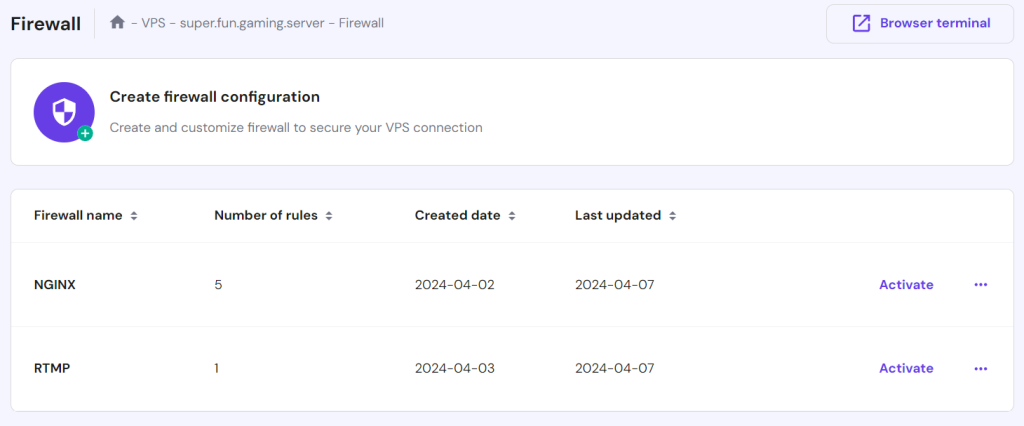
For Linux game servers, you can set a firewall rule using iptables or Uncomplicated Firewall (UFW). If you are unfamiliar with commands, set it up using a graphical user interface via hPanel’s Firewall menu.
Change the default port
In networking, a port identifies an endpoint for data exchange between services. An application uses a particular port number. For example, Minecraft’s dedicated server listens to port 25565 by default.
Since the default port always has the same value, cyber criminals might exploit it to gain access to your server. We recommend changing it and closing the unnecessary ones to minimize the attack surface.
Most games provide a configuration file to change the port, but closing other endpoints requires a firewall. Ensure no other services use the new port, as doing so might cause connection issues.
Scan malware
Malware is software that cyber criminals inject into your server for malicious purposes, like creating an entry point or stealing data. It can also waste your resources, making the hosted application unresponsive.
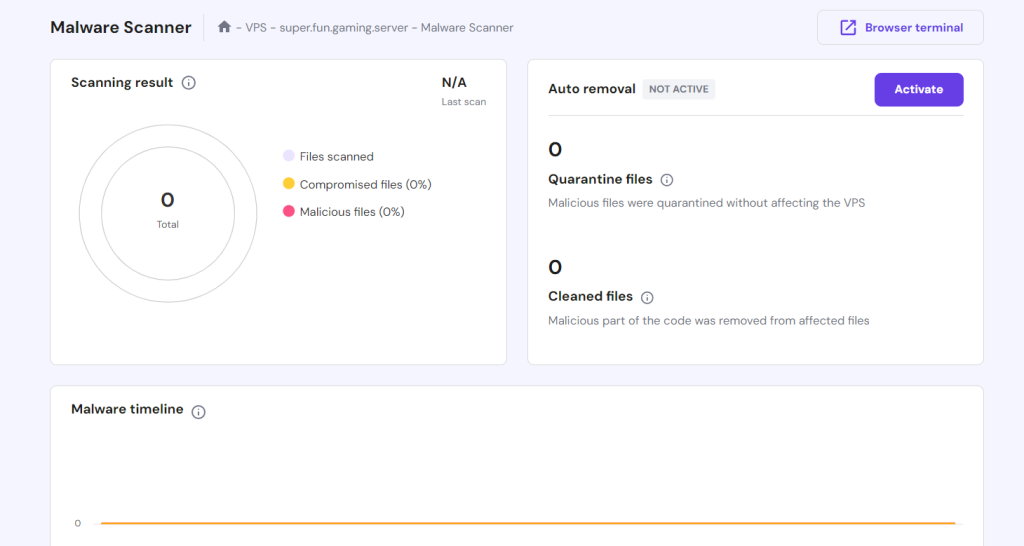
To maintain server security, regularly scan for malware to check if your system is infected. Hostinger users can do so using the built-in Monarx software. At an additional cost, they can also automatically remove malicious software in one click.
Back up your server
Backups maintain service availability and integrity. Regularly backing up your game ensures you have a data reserve to simplify the restoration process after severe errors or cyber attacks.
Hostinger users can easily do regular backups by enabling the automatic weekly backup feature. Our VPS also has a snapshot feature that captures your current system configuration for easier restoration or replication.
Conclusion
Optimizing your game server is crucial for a responsive and lag-free multiplayer gaming experience. In this article, we have explored six methods to do so:
- Optimize software by using a lightweight alternative, minimizing installed add-ons, and updating all packages regularly.
- Improve network performance by choosing the server closest to your player base and setting up a reverse proxy like Cloudflare Spectrum.
- Manage resources by dynamically allocating computing power to different server components using Docker.
- Change the game server settings, like minimizing the player slots, limiting the render distance, and reducing the RAM allocation.
- Monitor your server resource usage to identify deviations from the baseline performance.
- Set up a load balancer and scale your server to ensure you have enough computing resources.
In addition to performance, maintain your game server security to ensure data integrity and service availability. Important steps include setting up enabling automatic backups and setting up firewall rules, which you can easily do via Hostinger’s hPanel.
How to optimize a dedicated game server FAQ
In this section, we will answer several commonly asked questions about optimizing a dedicated game server.
What are the key factors for optimizing a dedicated game server?
Network and hardware usage are key considerations when optimizing a game server. Network affects latency and input responsiveness during gaming, while resource utilization impacts frame rates and loading time.
How can I reduce latency on my game server?
To reduce game server latency, choose a data center location closest to your player base. Also, set up multiple VPSs across the globe or use a reverse proxy so players can connect to the one with the lowest delay.
Can I monitor and analyze the performance of my optimized game server?
Absolutely! You can set up tools like Prometheus or use Hostinger’s built-in monitoring feature in hPanel and Game Panel. Tracking performance helps you catch issues quickly and ensure a responsive gaming server.


